Characterization of the climatic variables in the Gran Piedra mountainous area
Main Article Content
Abstract
The present work is carried out with the objective of characterizing the behavior of the climatic variables in the Gran Piedra mountainous area, based on the data of the meteorological station located in this area, in the province of Santiago de Cuba, using the SAROM Database. , the Microsoft Excel tool and graphic methods in the period (1981-2010), the variables were analyzed: relative humidity, temperature, precipitation, direction, wind force and the behavior of the days with the presence of meteorological phenomena: electrical storms, fog , hail and tornadoes. As a result, a climatic characterization of the study area is obtained, which can be a source of information for decision-making in the different socioeconomic sectors.
Downloads
Article Details

This work is licensed under a Creative Commons Attribution-NonCommercial 4.0 International License.
Those authors who have publications with this journal accept the following terms of the License Attribution-NonCommercial 4.0 International (CC BY-NC 4.0):
You are free to:
- Share — copy and redistribute the material in any medium or format
- Adapt — remix, transform, and build upon the material
The licensor cannot revoke these freedoms as long as you follow the license terms.
Under the following terms:
- Attribution — You must give appropriate credit, provide a link to the license, and indicate if changes were made. You may do so in any reasonable manner, but not in any way that suggests the licensor endorses you or your use.
- NonCommercial — You may not use the material for commercial purposes.
- No additional restrictions — You may not apply legal terms or technological measures that legally restrict others from doing anything the license permits.
The journal is not responsible for the opinions and concepts expressed in the works, they are the sole responsibility of the authors. The Editor, with the assistance of the Editorial Committee, reserves the right to suggest or request advisable or necessary modifications. They are accepted to publish original scientific papers, research results of interest that have not been published or sent to another journal for the same purpose.
The mention of trademarks of equipment, instruments or specific materials is for identification purposes, and there is no promotional commitment in relation to them, neither by the authors nor by the publisher.
References
Barry, R. G. (2008). Mountain weather and climate. Cambridge University Press. New York.
Centella. A., Naranjo. L., Paz. L., Cárdenas. P., Lapinel. B., Ballester. M., y otros (1997). «Variaciones y cambios del clima en Cuba». [inédito]. Informe Técnico. Centro Nacional del Clima. Instituto de Meteorología. La Habana. 58 pp.
de Estudios, O., & Agrarias, P. (2013). Estudio:“Cambio Climático Impacto en la Agricultura Heladas y Sequía”. Ministerio de Agricultura. Santiago, Chile.
González. C. & Ballester. M. (2000). Relaciones entre los patrones de la circulación general de la atmósfera y la actividad ciclónica. Boletín de la Sociedad Meteorológica. vol. (6). no. 1.
IPF. Instituto de Planificación Física. (2009). “Evaluación del impacto y vulnerabilidad de los asentamientos costeros por efecto del Cambio Climático y eventos meteorológicos severos a los años 2050 y 2100”. Primera parte. Informe Técnico del Proyecto 11. La Habana. 69 pp.
IPF. Instituto de Planificación Física. (2010). “Evaluación del impacto y vulnerabilidad de los asentamientos costeros por efecto del Cambio Climático y eventos meteorológicos severos a los años 2050 y 2100”. Segunda parte. Informe Técnico del Proyecto 11. La Habana. 67 pp.
IPCC. Panel Intergubernamental sobre Cambio climático. (2014). Cuba. Elementos a considerar en el desarrollo de acciones nacionales de enfrentamiento al Cambio climático. 2015/2030. Borrador 4.2. 15 septiembre 2014.
Lecha, L., Paz, L., & Lapinel, B. (1994). El clima de Cuba. Editorial Academia, La Habana, 186.
Lorente. M. et al. (1991). “Comportamiento de las variables climáticas y su interrelación con la ERA”.
Marchante. C.M. (2012). De cara al sol y en lo alto del Turquino. ISBN 978-959-274-124-9. p.19
Milanés Batista, C. (2015). La experiencia de la región Suroriental de Cuba en el enfrentamiento al cambio climático. Arquitectura y Urbanismo, 36(2), 120-127.
Miranda, J. D. (2008). Cambio climático y patrones de precipitación: efecto sobre las comunidades vegetales semiáridas. Ecosistemas, 17(3).
ONEI. (2017). ‘’Nomenclador de asentamientos humanos provincia Santiago de Cuba’’. Edición diciembre 2018.
ONU. Organización de Naciones Unidas (2003).
O.M.M. Organización Meteorológica Mundial (1979). “Reglamento Técnico No. 49”. Secretaria de la Organización Meteorológica Mundial” (O.M.M). Ginebra. Suiza.
IPCC. Panel Intergubernamental sobre el Cambio Climático (2014). “Cambio climático. Impactos, adaptación y vulnerabilidad”. Resumen para responsables de políticas.
Planos. E. O. (2012). “Informe sobre Impacto del Cambio Climático y Medidas de Adaptación en Cuba”.
Planos Gutiérrez, E., Rivero Vega, R., & Guevara Velazco, V. (2013). Impacto del cambio climático y medidas de adaptación en Cuba. Instituto de Metereología de la República de Cuba, La Habana (Cuba); Proyecto GEF/PNUD de la República de Cuba, La Habana (Cuba).
World Meteorological Organization. Tropical Cyclone Programme, & Holland, G. J. (1993). Global guide to tropical cyclone forecasting. Secretariat of the World Meteorological Organization.
WMO (1993). WMO/TD-No. 560. Tropical Cyclone Programe. Report No. TPC-31. Global Guide to Tropical Cyclone Forecasting.
Zúñiga López, I., & Crespo del Arco, E. (2018). Meteorología y Climatología, Editorial UNED, Madrid (2010).

